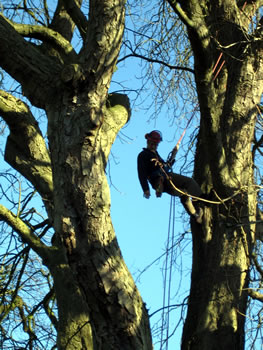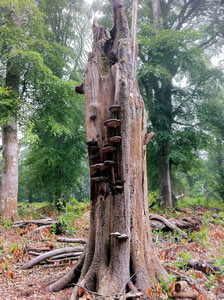What's an Arboriculturist? Jonathan Astill Aims to Shed Some Light
 When asked what I do for living, I tell people that I am an arboriculturist. This either meets with a blank expression or something along the lines of, "Oh, so you're a tree surgeon then."
When asked what I do for living, I tell people that I am an arboriculturist. This either meets with a blank expression or something along the lines of, "Oh, so you're a tree surgeon then."
Of course this is a normal response, as the people found scrambling skilfully around trees with a chainsaw dangling from their harness are the most visible and recognisable element of the arboricultural industry. By the way, I'm not a tree surgeon any more by trade, although I still climb trees to carry out aerial inspections. However, there are many other 'tree people' behind the scenes which have taken a role in shaping the urban forest. The skills required to plan, grow, select, plant, nurture and manage trees on public and private land within our towns and cities are multifaceted.
Two rather dry, but generally accepted definitions of arboriculture would be; 'the cultivation of trees and shrubs' (Concise Oxford Dictionary) and; 'the cultivation of trees in order to produce individual specimens of the greatest ornament and beauty, to provide shelter, to produce fruit or, for any primary purpose other than the production of timber as such' (N.D.G. James). Personally, I find both definitions a little unsatisfactory as neither of them address a very significant element - people!
'Arboriculture is essentially the management of trees wherever there are people.' (Me)
In the 1980's the Americans coined the term 'Urban Forestry' which is perhaps a more accurate reflection of the relationship between trees and the environment we have created for ourselves. In general terms the intensity of tree management increases with the density of the population. The more people there are, the more built structures there are, the greater the volume of traffic, more hard surfacing, road works and excavations, soil compaction, contamination, air pollution, so on and so forth. You get my drift. All of this creates a smaller and more hostile environment in which existing and new trees can thrive.
Yet we expect the trees in cities, towns and villages to do their job. They must soften and complement the hard edges of buildings, screen the eyesores, provide a habitat for the birds and bugs, embrace us with dappled shade on a hot day and wash the air of grubby pollutants. Subconsciously they give us an immense feeling of well-being which we are often oblivious to until the tree we have been quietly ignoring for years is felled. We expect the trees to be healthy and above all, we expect them to be safe.
Despite a universal claim for Joe Public to like or love trees, (I have yet to meet someone who says they don't like them) this ardour does not always begin at home. Trees can dominate people's property where space is at a premium, they block light and satellite receptions, dump copious quantities of leaves and twigs on to shiny cars and manicured lawns. Fears that trees will fall with disastrous consequences are commonplace. So too are assumptions that trees near buildings will damage the foundations. Such concerns and inconveniences give rise to the rash removal or mutilation of trees without careful consideration or advice from experienced and qualified professionals. The beauty of a tree is often beheld from a distance but not always loved 'in my back yard'. NIMBYism aside, a great deal of harm can also be inflicted on trees without any intent. Development and changes to the environment around trees often has an insidious impact on tree health which is not evident until long after the event.
 Cue the arboriculturists, in all their guises. Be it the nurserymen, the tree surgeons, the academics and researchers, policy makers, the local authority tree officers, surveyors and consultants.
Cue the arboriculturists, in all their guises. Be it the nurserymen, the tree surgeons, the academics and researchers, policy makers, the local authority tree officers, surveyors and consultants.
Trees need our physical and legal protection as they can't fend for themselves in the human domain. People need reassurance that the trees are not 'out to get them.' Claims of structural damage caused by trees should be fully investigated and confirmed before making knee-jerk reactions. Trees in built areas need to be surveyed and inspected by professionals who can identify and appraise the significance of disease and defects. Management of risk must always be proportionate. Careful consideration should be given to incorporating new buildings near existing trees or new trees near existing buildings. People who work with trees should keep their finger on the pulse and share their knowledge. People who love trees should continue to share their enthusiasm and shape their environment for the benefit of their children and townsfolk.
If you would like to discuss any of the matters in this article I would be happy to hear from you. Please contact me at .
For more information about me and my work please visit www.astilltreecare.co.uk
Comments
Login to comment!